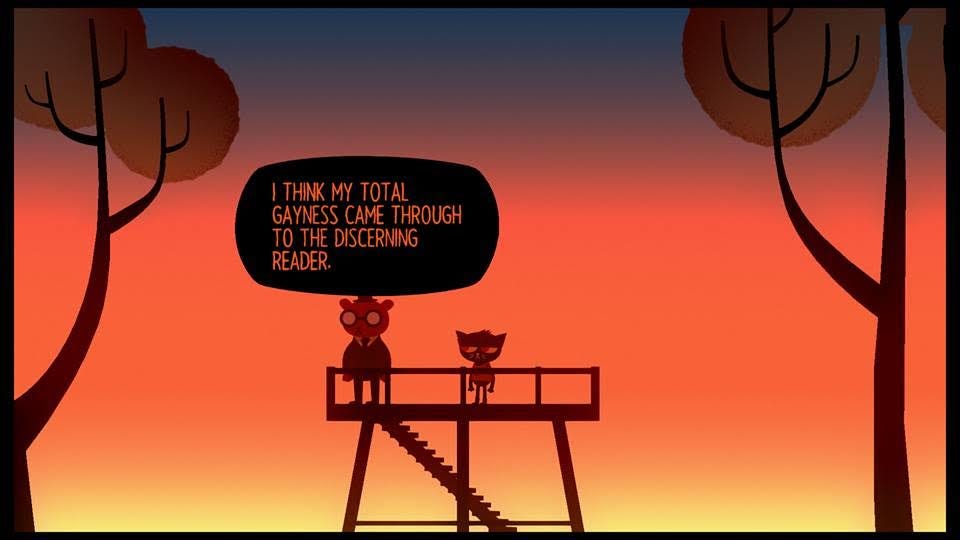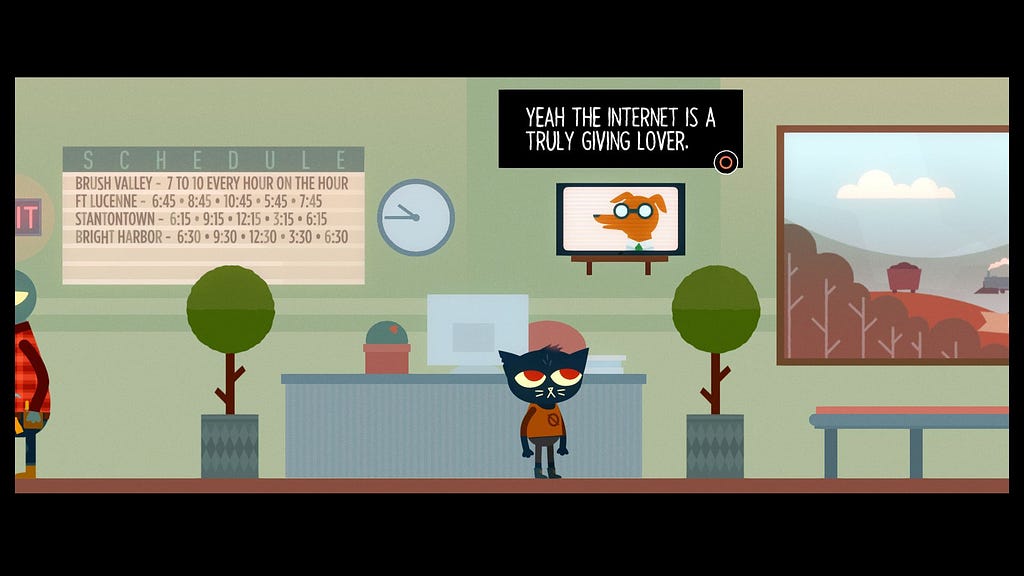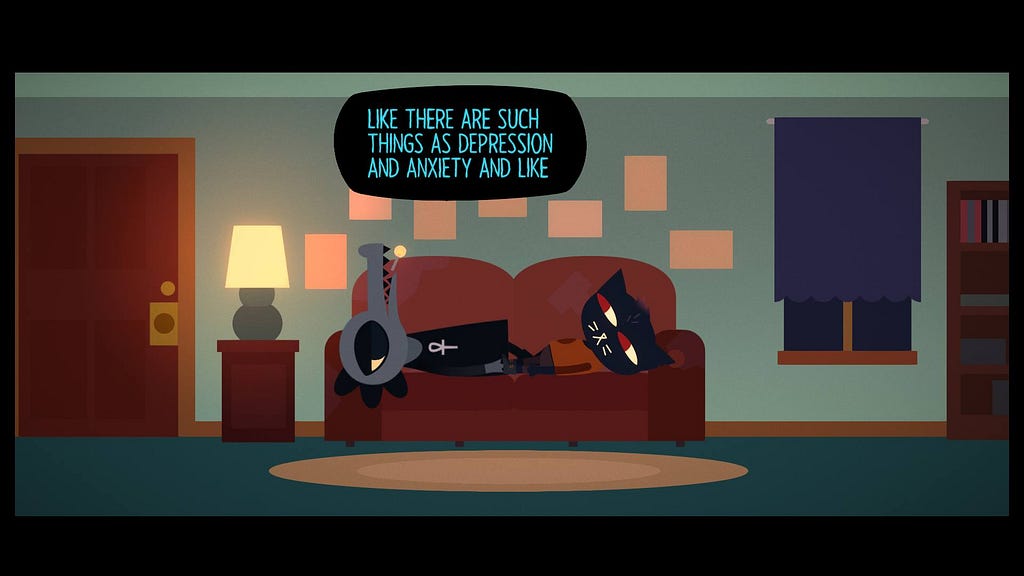
Bright looking with its colourful aesthetic and cute anthropomorphic cast, Night in the Woods seems pleasant and inviting. Yet this visual style merely seems like a way to soften the harsh realities the game explores. It tells the story of a town, Possum Springs, somewhere in the American Rust Belt (or somewhere just like it at least). The local coal mines long shut the town is a shadow of its glory days, reminded of its prosperous past by fading monuments. The game does not focus on the generation who lived through this decline however. It turns its attention towards the millennials growing up in its aftermath, raised in a town with few if any prospects, surrounded by constant reminders of a supposed better time.
Margaret ‘Mae’ Borowski has returned to her home town after an eventful drop-out from college. She seems keen to be back even if she evades her parent’s questions about what happened at college. Of course her return home, driven by nostalgia, meets harsh reality as she finds her friends saddled with jobs and the haunts of her youth closed down. Night in the Woods plays out one day at a time, with the player deciding who of their old friends to spend time with, while a mystery unravels over the course of the game. Not an entirely original coming of age story but in the medium of games, few if any have been attempted like this.

One important place where Night in the Woods differs from similar tales, including that of the lauded Kentucky Route Zero, is its muted exploration of queerness. At various points in the game Mae’s sexuality is hinted at, though never spelled out. At the request of some angsty teenagers blocking the way in a gloomy graveyard around the game’s midpoint, she can confess, depending on player choice, that she had a crush on a girl whilst at college (one which sadly ended in personal embarrassment). Later at a party she flirts with another young woman, though circumstances prevent us from seeing this potential relationship blossom. Mae doesn’t seem exclusively attracted to the same sex, claiming “she isn’t picky.” Her friends mention a brief period in which she dated a boy in high school though Mae seems uncomfortable with the memory.
Whilst it’s interesting how the game carefully weaves this facet of her identity throughout the game rather than through exposition, what I find fascinating is the way in which we see her sexuality regarded by different generations. Those her age make no comment on it whenever the topic is raised. During a hangout at a neglected mall, where Mae encourages her friend Bea to shoplift, she creates a distraction by flirting with the clerk. Though the clerk denies their advances, it’s simply because they’re already in a relationship and not an issue of gender. Two of her close friends in fact, Angus and Gregg, are in a queer relationship. This too is never questioned by their peers. Which also means that of the game’s main cast and Mae’s closest friends, only one of the four isn’t shown to be queer.

From the older generation we get a different outlook. Mae’s parents often ask if she’s dating anyone but they frame this specifically around asking whether she is “seeing a boy.” Heterosexual relationships are treated as the default by them and the expectation for Mae. The fact that Mae may be queer never occurs to them.
Whilst the older crowd, including Mae’s parents, seem pleasant towards Angus and Gregg a young neighbour describes the situation to Mae as “small town polite”. Mae’s parents ask after them but few comment on them as a couple. The impression given, if we read between the lines, is that their coupling is tolerated by the town’s older community but not encouraged. Gregg might be too fun loving to give much thought to it but Angus expresses some resentment for the treatment they’ve sometimes had to endure. A reminder, if one were needed, that rural environments are difficult for queer folk. Possum Springs is held back by both its ageing community and its isolated location.
Yet from their peers they have support. Not only do Mae and friends always try to meet up, especially for regular band practice, they keep in touch over online messaging when not physically together. This constant contact seems to result in an openness between them that is never shared by their parents. Mae’s mum and dad are seldom seen in the a room together, let alone speaking to each other, despite living in the same house. Night in the Woods depicts the Baby Boomer generation as emotionally guarded (perhaps understandably so given the economic decline they have lived through) whilst millennials are shown as more open. In what the game doesn’t say, we might wonder if plenty of the town’s older generation are every bit as queer as Mae and friends but unable to express it or connect with others.
Even as open as they are, they are still flawed in how they deal with their emotions, especially Mae. She takes a long time to open up over the course of the game about her depression and anger issues as well as her reasons for dropping out of college.

Mae was, for me, easy to identify with. Young, depressed and queer, I sympathised with her growing up in a post-industrial town and the isolation that comes from being keenly aware that your parents might not understand who you are. Worse, that there are no places where you might explore your identity or meet those like you. Her exploration of her sexuality is relatively minor in the grand scheme of the game’s plot but is a vital detail in helping illustrate the divide between the young and old. In its examination of this gulf, Night in the Woods gives voice to an often criticised generation and represents them with an authenticity often lacking. What it manages to say about the dynamics of being queer in a middle of nowhere town, small as it may be, is the part that lingers with me. In the progressive views of its youth, a mirror that holds up well to my lived experience, there is comfort to be found. Night in the Woods, for all its exploration of the harsh realities of post-industrial communities, asks millennials to find solace in our friends and their understanding. It’s not much in the face of economic uncertainty and lingering ignorance but it might be all we have.

Night in the Woods — Generational Divide and Queerness was originally published in Anomaly on Medium, where people are continuing the conversation by highlighting and responding to this story.
